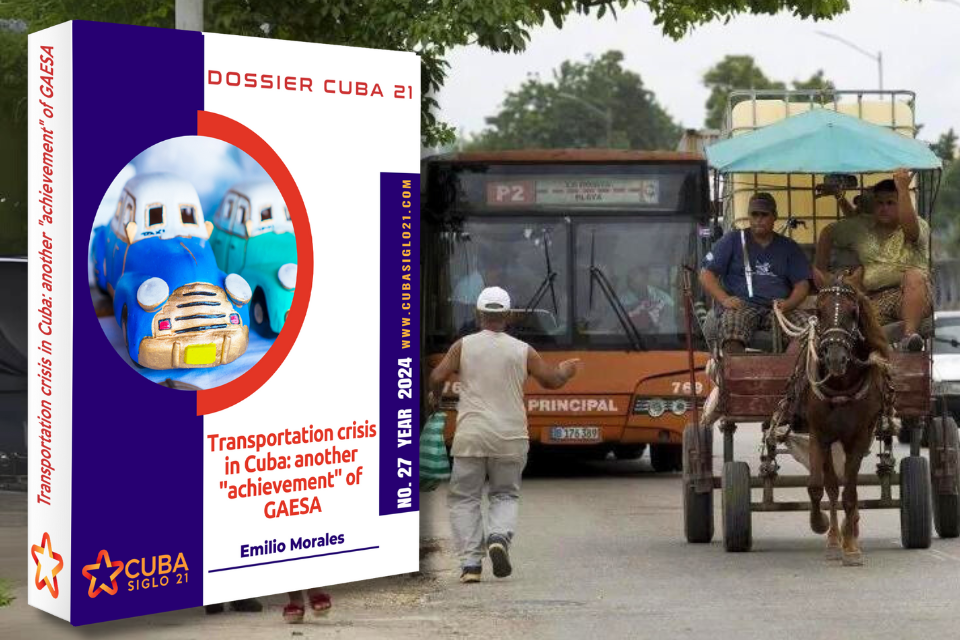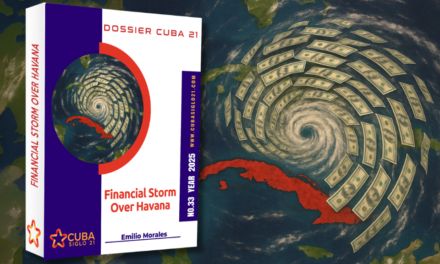Descargar informe completo PDF Español
Download Complete Report PDF English
If the energy system is important for a country, its transportation system is equally important. Without an efficient transportation system, it is impossible to develop a country’s economy. It depends on being able to synchronize the productive sector, marketing and consumption of a territory and establish synergies that allow the development of the market and companies. In the Cuban case, the collapse of the transportation system accelerates the collapse of the economy as a whole and prevents its recovery. All its branches are in crisis: air, maritime, land and rail. The most chaotic are the land and railways, which are designed to move the greatest volume of people and goods.
Passenger transportation on the verge of collapse
Passenger transportation is one of the problems that most affects the island’s economy. According to data published in the Cuban press, in the first semester of 2024, public transportation moved 48,860,000 passengers less than in 2019[i] , the year prior to the pandemic. The limitations in the availability of fuel, the lack of financing for the maintenance of the vehicle fleet and the purchase of spare parts, tires, batteries and other supplies have been the main causes of this disaster. In addition, there is a shortage of lubricants, greases and special liquids, which hampers the operation of the equipment, making it difficult to carry out the required periodic technical maintenance. The reality shows that public transportation on the island is in ruins.
For any citizen, the issue of transportation is a martyrdom. The crisis considerably limits their daily movements.
The transportation crisis is affecting all the territories of the country. Locally, all provinces present serious problems with the availability of transportation and especially with passenger transportation.
If we compare the statistics of the last 11 years on the number of passengers transported by bus we will see the disaster. According to data published by the National Office of Statistics and Information (ONEI) in 2013, 996.2 million passengers were transported by bus. In 2023, the figure was 479 million passengers, which means a drop of 51.92%. If we take as a reference for comparison the year 2019, the year prior to the pandemic, the drop was 56.54%. See Figure 1.
Figure 1. Historical series of passenger transport by bus. 2013-2023 (millions of passengers).

Source: Prepared by Havana Consulting Group based on data published by the National Statistics and Information Office (ONEI).
Transport crisis extends to freight distribution
Another major problem with the Cuban transportation system is the inefficiency in the transport and delivery of packages and parcels by the different freight forwarders operating in the market[i] There are currently six entities that operate as freight forwarders. The level of operations they carry out or the space they have available. Some could be described as large, such as Empresa de Mensajería de Correos de Cuba, Aerovaradero (belonging to the Cuban Civil Aviation Corporation) and Transcargo (also linked to the Ministry of Transportation); others medium-sized, such as the customs and freight forwarding agency belonging to the Palco business group and Cubapack (attached to CIMEX), and a relatively small one: Cubanacán Express (belonging to the Ministry of Tourism).
One of the most problematic entities is Correos de Cuba.
However, the most worrying aspect is not the inefficiency on the part of state entities in the delivery process and cargo handling, it is the decline of cargo transportation by motor transport in the last 11 years, which has fallen 49.49%. If we compare the year 2013 when 41.9 million tons of goods were transported with the year 2023, in which 21.19 million tons were transported we will see the disaster. See Figure 2.
Figure 2. Historical series of freight transportation by motor transport. 2013-2023 (thousands of tons).

Source: Prepared by Havana Consulting Group based on data published by the National Statistics and Information Office (ONEI).
Recently, on the radio program Mesa Redonda, several directors of the Cuban Union of Railroads (UFC) informed that 67% of the country’s railroads require some kind of maintenance, as well as 40% of the infrastructure works[i] . In addition to the poor condition of the tracks, only 12 of the 34 large locomotives required for cargo and passenger transportation are in operation. The UFC has 291 locomotives, 5,100 freight cars, 37 motor cars and 71 Ferrobuses. In addition, it has 173 passenger cars, 7 main repair shops, 21 heavy operation and maintenance shops, and 79 overhaul and light maintenance shops[ii] .
To guarantee the sustainability of the railway infrastructure, 900 million pesos a year are required, a large part of which is in foreign currency, specifically 25 million dollars for materials, supplies and parts, according to Lisvany Fernández Rivero, acting general director of the Railway Transport Administration, who stated on the television program “La Mesa Redonda” a few weeks ago[iii] .
Regarding the available locomotive fleet, the situation is extremely critical. Of the locomotives in operation, only 12 are large locomotives, when 34 are actually needed, so the deficit of this type of locomotives is 64.7%. This has caused serious problems with freight transportation, which is responsible for the transportation of basic foodstuffs, sugarcane harvest and construction materials such as cement and aggregates. In addition, it is the main means for the operation of the cargo of the Port of Mariel, the transfer of fuel and chemicals, to mention the heaviest ones.
This situation has caused a considerable decrease in the country’s cargo transportation, which has had a negative impact on the rest of the industries and the sectors that depend on it.
To get an idea of the size of this catastrophe, it is enough to analyze the statistics related to rail freight transportation over the last 11 years. In 2013, 16.87 million tons were transported by rail, while in 2023 just 5.01 million tons, representing a drop of 70.28%. See Figure 3.
Figure 3. Historical series of freight transportation by rail transport. 2013-2023 (thousands of tons).

Source: Prepared by Havana Consulting Group based on data published by the National Statistics and Information Office (ONEI).
Statistics on passenger transportation by rail show the disaster. In 2013, 10 million passengers were transported by rail, while in 2023 it was barely 4 million, a decline of 60%. See Figure 4.
Figure 4. Historical series of passenger transport by train. 2013-2023 (millions of passengers).

Source: Prepared by Havana Consulting Group based on data published by the National Statistics and Information Office (ONEI).
The desperate search for foreign investment that does not arrive
Last April, the Cuban government organized the II edition of the International Transport and Logistics Fair, with the aim of attracting foreign investment in the transport sector. According to the Minister of Transportation, the event was attended by more than 120 exhibiting entities and 600 participants from all forms of business management[i] .
However, there is no indication that the renowned and highly publicized fair has yielded any positive results in the form of foreign investment contracts in any of the transportation branches. This suggests that there will be no improvement in the short and medium term, so the situation of the sector will continue to be in crisis in the coming years.
Conclusions
The transportation sector is another important sector of the economy that is a victim of the looting and the control that GAESA -the main oligarchic-mafioso organization of the Cuban regime- has over the country’s finances. The scarce investments and the precariousness of its infrastructure demonstrate this. The transportation sector, far from helping the development of enterprises, has contributed to the collapse of the economy.
The island’s transportation system is in very poor condition. Statistics for the last 11 years show this. In that period, passenger transportation by bus has fallen 51.02%, while by rail has decreased 60%. The situation of cargo transportation shows an even more critical picture. By automobile, the decline has been 49.49%, and by railroad it has been 70.28%.
These indicators show the involution of the country’s transportation system in the last 11 years. This disaster is one more example that corroborates in practice the power that GEAESA has over the state, its president Miguel Díaz Canel and the government team that accompanies him, who have not been able to distribute the country’s investments effectively in the most priority sectors of the Cuban economy. In any case, they have had to submit to the directives of GAESA, which is in fact the power that decides where investments are capitalized in the country. As has already been demonstrated in previous research reports, these investments have been concentrated in recent years mainly in the tourism industry, specifically in the construction of new hotels under its control, an industry that is operating at less than 50% of its lodging capacity.
Investments in all branches of the transportation sector are very limited. This, among others, is the reason why the country’s economy is stagnant in all its sectors, being very critical the situation of the most strategic ones: sugar industry, agriculture, public transportation, industrial production, energy matrix, among others. However, it has invested without sparing any limits in the transportation of the different components of its repressive forces -black visas, red berets, police, security- relegating the needs of the population to give priority to the exercise of terror to contain and subdue any attempt of citizen revolt. That is the top priority for the GAESA oligarchy.
The precariousness of the transportation sector on the island has generated a cascade of negative consequences that not only impede the country’s business development, but also threaten the very survival of citizens. The critical state of public transportation limits the movement of citizens, which is essential for companies to operate properly and synchronized. The crisis of the sector has put the country on the verge of an epidemiological crisis due to the agglomeration of garbage in the streets given the lack of transportation to collect it. It has even been a factor that has had an impact on the decrease of the country’s tourist attractiveness, which is consequently reflected in the decrease of tourist arrivals and the failure of the recovery of this sector in the post-pandemic stage. The transportation crisis has been another reason why more than 1.7 million people have left the country in the last three years[i] .
Without any doubt today we can affirm that “with GAESA there is (and will be) no country”.
Referencias
[i] Albizu-Campos, Juan Carlos. “Cuba. A quick look at emigration and population”. July 2024. Columbia Law School. https://horizontecubano.law.columbia.edu/news/cuba-una-rapida-mirada-la-emigracion-y-la-poblacion
[i] CUBADEBATE. “The II edition of the International Transport and Logistics Fair opens its doors”. APRIL 2024. http://www.cubadebate.cu/noticias/2024/04/03/abre-sus-puertas-la-ii-edicion-de-la-feria-internacional-del-transporte-y-logistica/
[i] CUBANET. “Victims of the crisis: the railroad and cargo transportation in Cuba”. MARCH 2024. https://www.cubanet.org/victimas-de-la-crisis-el-ferrocarril-y-el-transporte-de-carga-en-cuba/
[ii] CUBADEBATE. “Realities and challenges of the railway activity in Cuba”. MARCH 2024. http://www.cubadebate.cu/noticias/2024/03/06/realidades-y-desafios-de-la-actividad-ferroviaria-en-cuba-video/
[iii] ROUND TABLE. “The Cuban Railway System”. 2024 https://www.youtube.com/watch?v=CgO4dLsXJkY
[i] REBELLIOUS YOUTH. “Complaints persist in the work of freight forwarders.” October 9, 2023. https://www.juventudrebelde.cu/cuba/2023-10-09/persisten-quejas-en-la-labor-de-las-transitarias
[i] DDC. “In the first half of 2024 public transport in Cuba moved almost 50 million passengers less than in 2023.” August 18, 2024. https://diariodecuba.com/cuba/1723988902_56657.html







